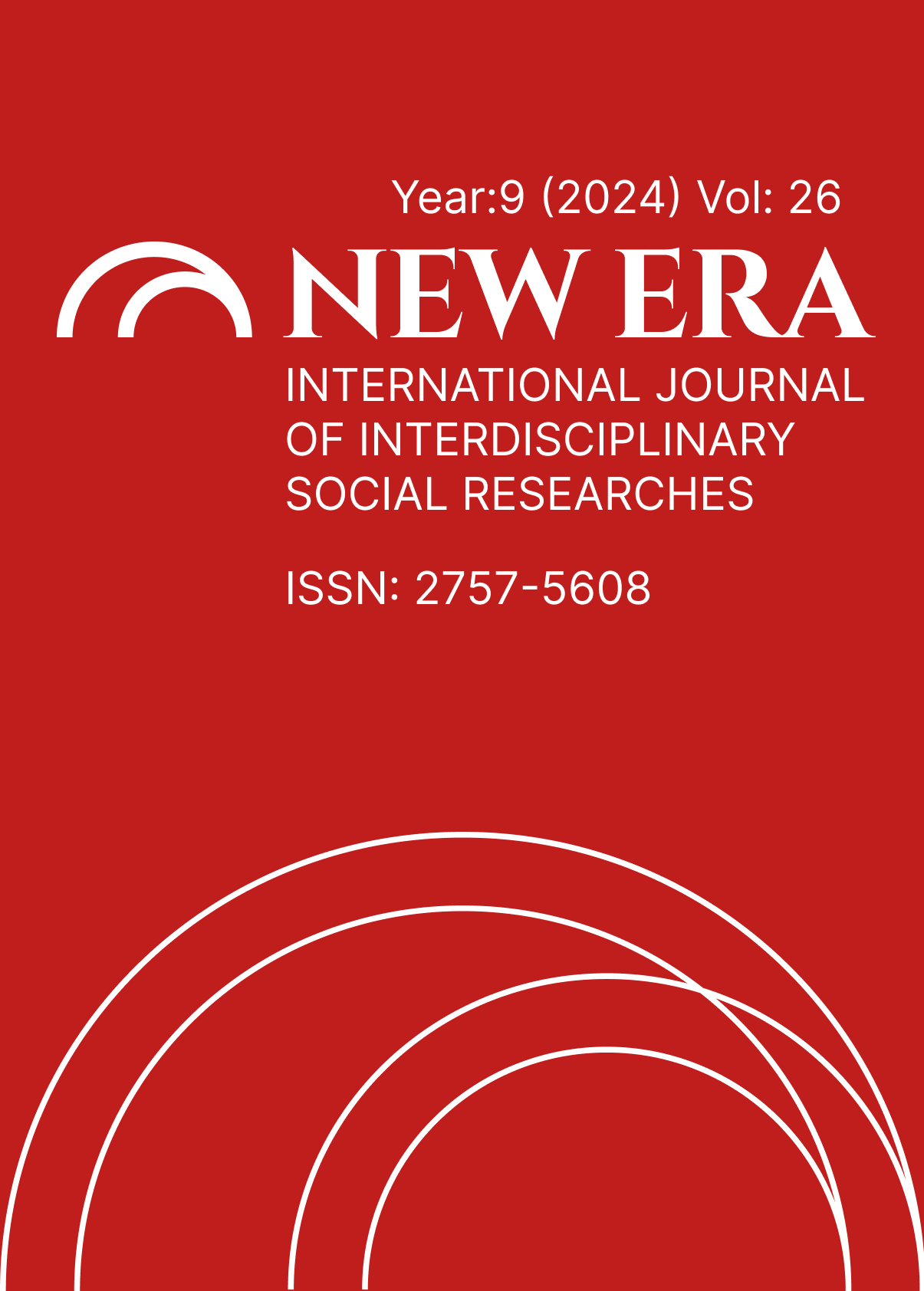THE EXPECTED MARMARA EARTHQUAKE: RISKS, PREPARATIONS, AND POTENTIAL IMPACTS ON TURKEY'S HEARTLAND
DOI:
https://doi.org/10.5281/zenodo.14553418Abstract
Turkey is located in one of the most seismically active zones in the world due to its tectonic structure. A significant portion of the country lies on active fault lines, making it frequently exposed to earthquakes. Throughout its history, Turkey has experienced many devastating earthquakes, with the Gölcük Earthquake of August 17, 1999, standing out as a major event causing significant loss of life and property. Such major earthquakes have left lasting marks on the country's geographical and demographic landscape.
The Marmara Region is one of the most earthquake-prone areas in Turkey, directly influenced by the North Anatolian Fault Line. This fault line, stretching from Karlıova in Bingöl in the east to the Saros Gulf in the west, is known as one of Turkey's most active fault systems. Numerous large earthquakes have occurred along this fault line throughout history, significantly impacting the Marmara Region. Cities like Istanbul, Kocaeli, Sakarya, and Yalova face high risks due to their proximity to this fault line.
The anticipated Marmara Earthquake is a natural disaster that scientists have been studying for many years and is considered highly likely to occur. Geological and seismic data indicate substantial stress accumulation, particularly in the segment beneath the Marmara Sea. The rupture of this segment could trigger an earthquake of magnitude 7.0 or higher. As Turkey's largest metropolis, Istanbul is expected to be one of the most affected cities. Due to its dense population and role as the economic hub of the country, such a major earthquake could cause severe damage to the city.
The major earthquake expected to occur in Istanbul and its surroundings would not only impact the local population but also the entire nation. The Marmara Region is the backbone of Turkey's economy, serving as the center of industries such as manufacturing, trade, and finance. Istanbul alone accounts for more than 40% of the country's trade volume and represents Turkey's largest economic powerhouse. Consequently, a seismically active region with such economic and population density facing a devastating earthquake could have profound implications for the entire nation.
In addition to the potential loss of life and property caused by an earthquake in the Marmara Region, large-scale disaster scenarios could also emerge, including infrastructure damage, the collapse of transportation networks, and disruptions in basic services such as electricity, water, and natural gas. Therefore, studies and preparation processes regarding the potential impacts of the Marmara Earthquake are of vital importance not only for the safety and well-being of the local population but also for the prosperity of all of Turkey.
Efforts in earthquake preparedness, such as urban transformation projects, public awareness programs, and the reinforcement of building stocks against earthquakes, play a critical role in minimizing the adverse effects of this major natural disaster. However, considering the severity of the potential aftermath of the Marmara Earthquake, whether the measures taken so far are sufficient remains a subject of debate. The effective implementation of earthquake precautions across all sectors of society is crucial for accelerating post-earthquake recovery and minimizing losses.
References
AFAD. (2021). Türkiye’nin deprem tehlikesi ve risk analizi.
Ambraseys, N. N. (2002). Historical seismicity in the Marmara region. Earthquake Studies.
Boğaziçi Üniversitesi Kandilli Rasathanesi. (2020). Deprem istatistikleri ve analizleri.
Çakmak, A. S. (2015). Deprem risk yönetimi ve kentsel dönüşüm. Yapı Dergisi.
Erdik, M. (2004). Depremler ve Türkiye. Deprem Mühendisliği Konferansı Bildirileri.
İstanbul Büyükşehir Belediyesi (İBB). (2020). İstanbul’un deprem hazırlık çalışmaları raporu.
KPMG Türkiye. (2019). Marmara Bölgesi’nin ekonomik önemi.
Kandilli Rasathanesi. (2020). Marmara Depremi simülasyonları ve raporlar.
Şahin, C. (2017). Türkiye’de deprem yönetimi. Afet Yönetimi Araştırmaları.
Şaroğlu, F. (1992). Kuzey Anadolu Fay Hattı’nın jeolojik özellikleri.
TÜİK. (2020). Marmara Bölgesi’ne ilişkin nüfus ve ekonomik istatistikler.
Güler, H. (2018). Türkiye'nin deprem politikaları. Afet Yönetimi Yayınları.
Özdemir, S. (2016). İstanbul’da yapı stoğunun analizi. Yapı Dergisi.
Doğan, B. (2015). Marmara Denizi fay hatlarının analizi. Jeoloji Bülteni.
Balcı, T. (2020). Depremlerin sosyoekonomik etkileri. Ekonomi ve Afet Araştırmaları Dergisi.
Kaya, E. (2017). Türkiye’de kentsel dönüşüm politikaları. Planlama Dergisi.
Uslu, K. (2014). Marmara Bölgesi’nde riskli alanların tespiti. Jeoloji Mühendisliği Dergisi.
Yıldırım, M. (2018). Kuzey Anadolu Fay Hattı ve tarihi depremler. Coğrafya Dergisi.
Polat, R. (2019). Marmara Depremi’nin altyapıya etkileri. Afet Yönetimi Konferansı Bildirileri.
Yüksel, T. (2016). İstanbul’un deprem sonrası toparlanma süreci. Afet Çalışmaları Bülteni.
AFAD. (2021). Türkiye Afet Risk Azaltma Planı 2023. Afet ve Acil Durum Yönetimi Başkanlığı.
Boğaziçi Üniversitesi Kandilli Rasathanesi. (2020). Sismik ve Deprem Verileri. Boğaziçi Üniversitesi.
Erdik, M. (2004). 1999 Gölcük Depreminin Ekonomik Etkileri. İstanbul Teknik Üniversitesi Yayınları.
İBB. (2020). İstanbul Deprem Stratejisi. İstanbul Büyükşehir Belediyesi.
KPMG Türkiye. (2019). Türkiye Ekonomisi: Deprem Riskleri ve Ekonomik Etkiler. KPMG Türkiye.
Şahin, H. (2017). Marmara Depremi ve Sosyal Etkileri. Afet ve Kriz Yönetimi Yayınları.
Erdik, M. (2004). İstanbul ve Marmara Bölgesi’nde deprem riski. Deprem Araştırma Raporları, 12(1), 17-26.
Korkmaz, K. (2015). Depreme dayanıklı yapı tasarımı ve güçlendirme teknikleri. Mühendislik ve Mimarlık Dergisi, 8(3), 34-48.
Downloads
Published
How to Cite
Issue
Section
License
Copyright (c) 2024 NEW ERA INTERNATIONAL JOURNAL OF INTERDISCIPLINARY SOCIAL RESEARCHES

This work is licensed under a Creative Commons Attribution-NonCommercial 4.0 International License.


